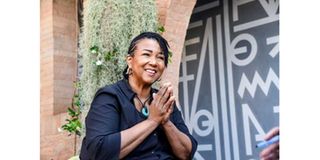Dr Mae Jemison: First African American woman to travel to space

Mae Jemison, former NASA astronaut, during an interview at Tribe Hotel, Gigiri, Nairobi, on December 1, 2022.
What you need to know:
- In an exclusive interview with Nation.Africa in Nairobi, she shared that she does not consider herself as the first woman of colour capable of going to space.
- She maintained that she stood on the shoulders of many other great women who had paved the way for her success.
Dr Mae Jemison wears many hats; she is an engineer, a medical doctor, an entrepreneur and a former astronaut. Still, that is not the full extent of the phenomenal woman that she is. Jemison made history in 1992 by becoming the first African American woman to travel to space. This was when she served as a mission specialist aboard the space shuttle called Endeavour.
Even so, in an exclusive interview with Nation.Africa in Nairobi, she shared that she does not consider herself as the first woman of colour capable of going to space. Instead, she maintained that she stood on the shoulders of many other great women who had paved the way for her success.
“There were women who clearly had the skills and capacity before me. I know women who were in the sciences way before me. I am an under no impression that I was the first woman of colour to have the capability and skills to go to space,” Dr Jemison says.
Space exploration
She references popular Netflix historical drama, Hidden Figures, to explain that African-American women played critical roles in space exploration even as early as the 1950s and 60s.In the film, Katherine Johnson, Dorothy Vaughan and Mary Jackson are depicted processing aeronautical data that was pivotal for NASA’s trailblazing space flights.
“African women were involved in space exploration for a very long time, people just didn’t talk about us. Even though they were not astronauts, they were involved in other critical ways. They were doing the calculations or building the equipment. Astronauts are just a public face on it,’’
In May 1961, the United States with Project Mercury sent Alan Shepard, the first American, into space. Dr Jemison explains how as a young girl growing up in Chicago, USA, she watched Valentina Tereshkova, a Russian woman, go to space in 1963.
However, it took another 30 years for Dr Jemison, the first African American woman, to go to space. She explains why it took so long:
“When NASA first planned to take people to space, the Mercury 13: Women in Spaceflight Program was initiated to test and screen women for spaceflight. The women tested had incredible experiences as pilots and it was found that women were in fact competent for spaceflight.
“This is because, first of all, they were smaller, so you have less oxygen requirements. When they asked psychologists, they were told that women would be more stable in space. In isolation tests, the women were better than men in tolerating it, but NASA just decided to go with men. It has nothing to do with psychology or capability, even though that is what people would like you to believe, but it has everything to do with socio-cultural issues.”
Inclusivity
It is against this history of women’s participation in space exploration that Dr Jemison feels that by being the first, she has a responsibility to make space inclusive. This explains why she is visiting Nairobi.
In celebration of her audacious initiative, the 100 Year Starship, she is in Nairobi to hold a hybrid symposium with people from all walks of life to discuss the approach to space exploration.
Dr Jemison says the project, which would also be marking its 10th anniversary, was started to ensure human space travel to another star is possible within the next 100 years.
“We are trying to build capabilities, not a launch day. This is completely different from trying to go to the moon, or Mars or Pluto. It’s a completely different phenomenon, you need so much more energy and investment.”
How does she plan to do this?
She believes that her interdisciplinary background is part of her success today.
“By the time I got to NASA, I had worked as an area peace corps officer in Sierra Leone and Liberia. I did my undergraduate in engineering and majored also in African Studies then I went to medical school and worked in refugee camps. So I bring all these experiences on the solutions that I come up with.”
In the same vein, she hopes to build an inclusive initiative where people from across genders, ethnicities, geographies, race and disciplines can participate.
Dr Mae Jemsion has received numerous awards and recognitions over the years, including being inducted into the National Women’s Hall of Fame and the Kilby Science Award.
She has also written books such as The 100 Year Starship in 2013 and Find Where the Wind Goes: Moments from My Life, an autobiography published last year. In her free time, she enjoys dancing.





